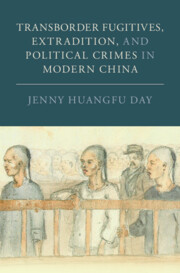Refine search
Actions for selected content:
225 results
9 - Revolution and Intervention, 1917–1920
-
- Book:
- Distant Friends and Intimate Enemies
- Published online:
- 30 October 2025
- Print publication:
- 20 November 2025, pp 179-195
-
- Chapter
- Export citation
1 - The Emerging Crisis (to December 1964)
-
- Book:
- Waging Peace
- Published online:
- 03 November 2025
- Print publication:
- 13 November 2025, pp 8-38
-
- Chapter
- Export citation

Transborder Fugitives, Extradition, and Political Crimes in Modern China
-
- Published online:
- 10 November 2025
- Print publication:
- 30 October 2025
2 - Spies, Masons, and “Purely Communist”
-
- Book:
- In the Shadow of the Vatican
- Published online:
- 23 October 2025
- Print publication:
- 06 November 2025, pp 60-90
-
- Chapter
- Export citation

Distant Friends and Intimate Enemies
- A History of American-Russian Relations
-
- Published online:
- 30 October 2025
- Print publication:
- 20 November 2025
7 - Republican China’s Quest for Judicial Sovereignty and the Criminalization of Communism
-
- Book:
- Transborder Fugitives, Extradition, and Political Crimes in Modern China
- Published online:
- 10 November 2025
- Print publication:
- 30 October 2025, pp 180-209
-
- Chapter
- Export citation

In the Shadow of the Vatican
- Texan Evangelical Missionaries in Cold War Italy
-
- Published online:
- 23 October 2025
- Print publication:
- 06 November 2025
Circulating Violence: Guerre contre-révolutionnaire as the Intellectual Foundation of Modern Torture
-
- Journal:
- Comparative Studies in Society and History , First View
- Published online by Cambridge University Press:
- 17 October 2025, pp. 1-27
-
- Article
-
- You have access
- Open access
- HTML
- Export citation
31 - Twentieth-Century Czech Female Composers in Cultural and Political Context: The Pre-1989 Music of Ivana Loudová and Sylvie Bodorová
- from Part III - The Twentieth Century and Beyond
-
-
- Book:
- A History of Music in the Czech Lands
- Published online:
- 21 October 2025
- Print publication:
- 16 October 2025, pp 436-449
-
- Chapter
- Export citation
24 - The Nation’s Image in Songs: Folk Music Research and Revival in the Twentieth Century
- from Part III - The Twentieth Century and Beyond
-
-
- Book:
- A History of Music in the Czech Lands
- Published online:
- 21 October 2025
- Print publication:
- 16 October 2025, pp 335-348
-
- Chapter
- Export citation
Chapter 3 - Socialist Competition
-
-
- Book:
- Questioning Conventional Assumptions of Competition Dynamics
- Published online:
- 07 May 2025
- Print publication:
- 21 August 2025, pp 58-97
-
- Chapter
- Export citation
1 - Loyalists
-
- Book:
- Making Antifascist War
- Published online:
- 28 October 2025
- Print publication:
- 14 August 2025, pp 29-63
-
- Chapter
- Export citation
Introduction
-
-
- Book:
- Antifascism(s) in Latin America and the Caribbean
- Published online:
- 21 July 2025
- Print publication:
- 07 August 2025, pp 1-22
-
- Chapter
- Export citation
2 - Decolonisation and the Global Cold War
- from Part I - Non-Sovereign States in the Context of Global Decolonisation
-
- Book:
- Global Decolonisation and Non-Sovereignty
- Published online:
- 16 September 2025
- Print publication:
- 31 July 2025, pp 59-87
-
- Chapter
- Export citation
Lightning-Sword and Blazing Steed under the Hammer and Sickle: The Rebirth of David of Sassoun in Soviet Armenia
-
- Journal:
- Nationalities Papers , FirstView
- Published online by Cambridge University Press:
- 30 July 2025, pp. 1-27
-
- Article
-
- You have access
- Open access
- HTML
- Export citation
Chapter 30 - The Central European Stage
- from Part IV - Performance Legacies
-
-
- Book:
- Sean O'Casey in Context
- Published online:
- 23 June 2025
- Print publication:
- 10 July 2025, pp 329-339
-
- Chapter
- Export citation
Chapter 18 - Bernard Shaw
- from Part III - Collaborators and Critics
-
-
- Book:
- Sean O'Casey in Context
- Published online:
- 23 June 2025
- Print publication:
- 10 July 2025, pp 192-201
-
- Chapter
- Export citation
Chapter 7 - Class
- from Part II - Social Contexts
-
-
- Book:
- Sean O'Casey in Context
- Published online:
- 23 June 2025
- Print publication:
- 10 July 2025, pp 79-88
-
- Chapter
- Export citation
Chapter 4 - The Second World War
- from Part I - Key Places and Events
-
-
- Book:
- Sean O'Casey in Context
- Published online:
- 23 June 2025
- Print publication:
- 10 July 2025, pp 45-56
-
- Chapter
- Export citation
6 - The Institutional Genes of Totalitarian Ideology
-
- Book:
- Institutional Genes
- Published online:
- 03 June 2025
- Print publication:
- 26 June 2025, pp 202-260
-
- Chapter
- Export citation
